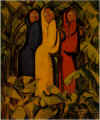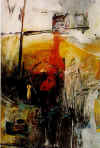|
|
||||
|
Home
Book Reviews Silk Road on Wheels
|
|
|
||
|
the-south-asian.com November 2000 |
||||
|
‘Contemporary Art in Bangladesh’
‘Contemporary Art in Bangladesh’ – a special volume brought out by Art & The Islamic World (UK) Ltd, was published to celebrate 50 years of the Institute of Fine Art, University of Dhaka. The Institute was earlier known as Government Institute of Art and was founded by the well-known artist Zainul Abedin and some of his colleagues in 1948. ‘Contemporary Art in Bangladesh’ is a fine collection of articles with photographs of paintings seldom seen in any other publication. Syed Manzoorul Islam has surveyed the development of art from Bengal School to Bangladeshi Art. His article is an explicit account of the political and social milieu in which contemporary art evolved in Bangladesh. The history of contemporary art in Bangladesh begins effectively at the time of partition of the subcontinent in 1947, when Zainul Abedin (who came into public eye with his sketches of the Bengal Famine of 1943) and some of his colleagues from West Bengal, who opted to settle down in East Bengal, set up the first art school in the newly formed state. Zainul Abedin was the first Principal. This institute trained and nurtured an entire generation of new artists whose work reflected the changing times. Qamrul Hasan, Saifuddin Ahmed, Anwarul Haq were contemporaries of Zainul Abedin. This was the generation that depicted social reality in their art. The art of the fifties was a different story. As Manzoorul Islam explains " The fifties painters took to abstraction…. for two reasons. First, it was an inner compulsion, an urge to express themselves through a language, through metaphors, images, sensibilities and symbolism that they thought most clearly represented their artistic, emotional and intellectual understanding of their art. The second reason can be ascribed to a social compulsion. The establishment… disapproved of any human or figurative representation as it supposedly contravened religious strictures." Mohammad Kibria was one of the outstanding artists of the fifties, as Monirul Islam was of the sixties.
The sixties also saw artists and sculptors such as Abu Taher, Samarjit Roy Chowdhury, Anwar Jahan and many other notable names. The creation of Bangladesh as a separate entity influenced the art of the 70s. Abul Mansur writes, " A new generation of artists came to the scene who adopted a more figurative language and tried to initiate an interaction between the traditional and the contemporary. A good number of artists, including sculptors and printmakers, began to work in more varied and innovative styles." The notable painters of the 70s were Monirul Islam, Shahid Kabir, Mahmudul Haque, Kalidas Karmarkar among other well-known names.
Writing on the contemporary art scene, Moinuddin Khalid describes how some of the artists are involved with "analytical realism". "There is at the same time, a sustained satiric tone that brings out the themes as well as identifies the artists’ position and their commitment to the society…Reconstruction of myth is also a characteristic of contemporary art. Painters are going back to the mythical past for themes and symbols….Artists are also going back to folk art – although in a much more limited way" – he adds. Among the women artists of Bangladesh – the work of Novera Ahmed finds special mention. A sculptor of the fifties, Novera did figurative works. Farida Zaman has also won national accolades for her work. The art world in Bangladesh received an impetus when the government of Bangladesh organised the First Asian Art Biennial in 1981. It is a month long event held every two years in Dhaka where Asian countries exhibit contemporary works of paintings, sculptures and graphics. Nine such Art exhibitions have been held so far. The Bangladesh Shilpakala Academy provided the transparencies and photographs for the selection of paintings and sculptures. ‘Contemporary Art of Bangladesh’ is a well-written record of the history of contemporary art in the country. The visuals are stunning and so are the layouts. A must for South Asian art lovers. _____ |
||||
| Copyright © 2000 [the-south-asian.com]. Intellectual Property. All rights reserved. | ||||
| Home |





